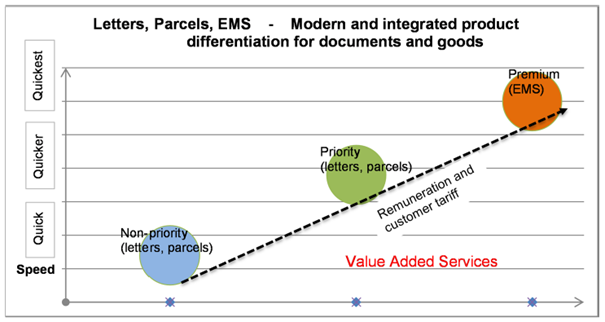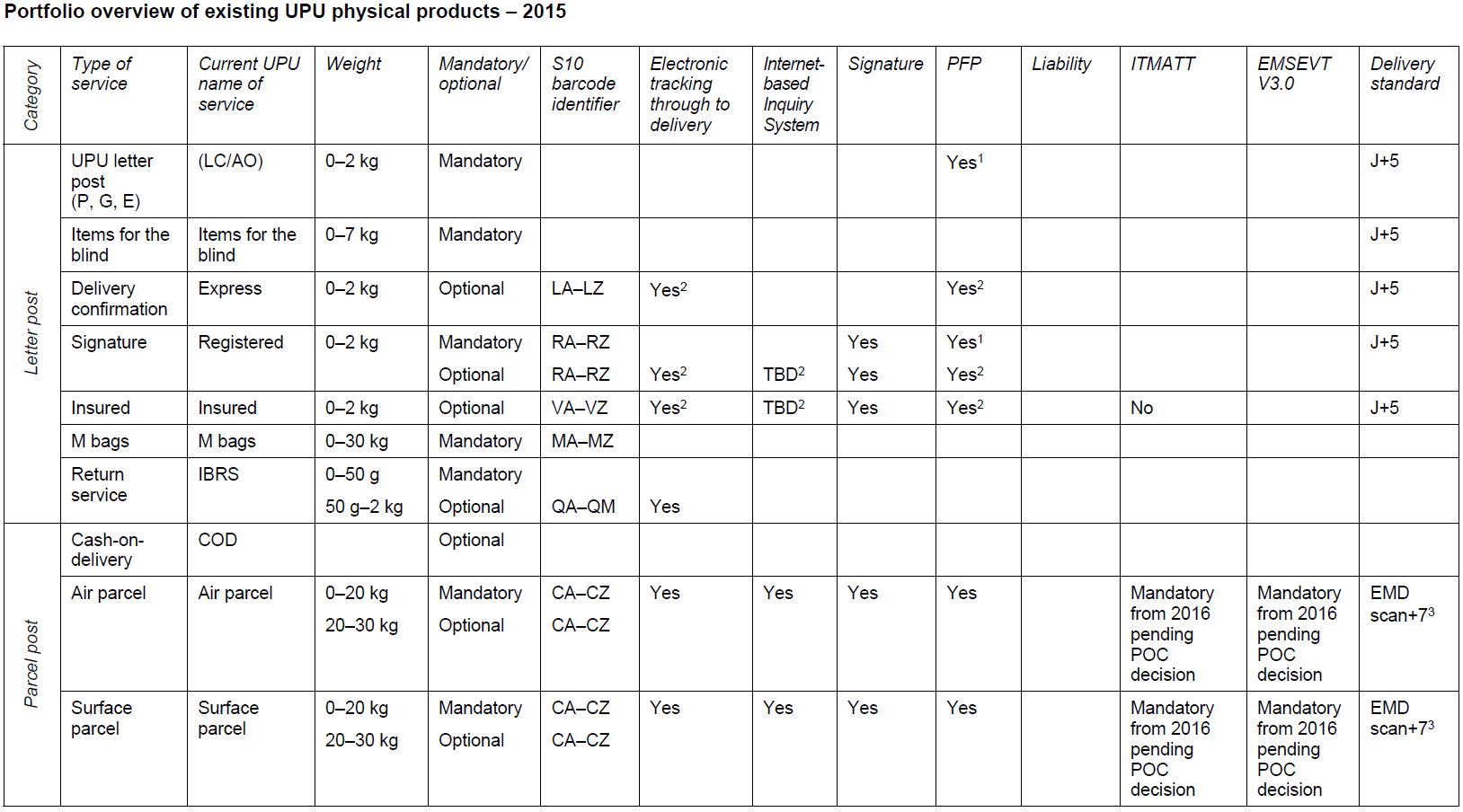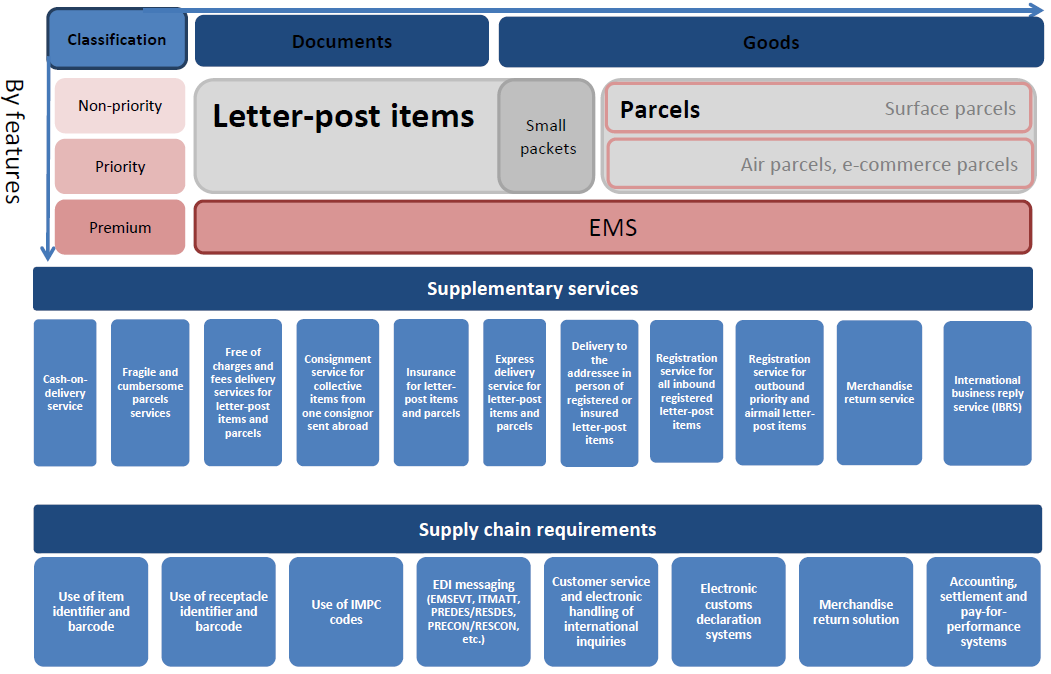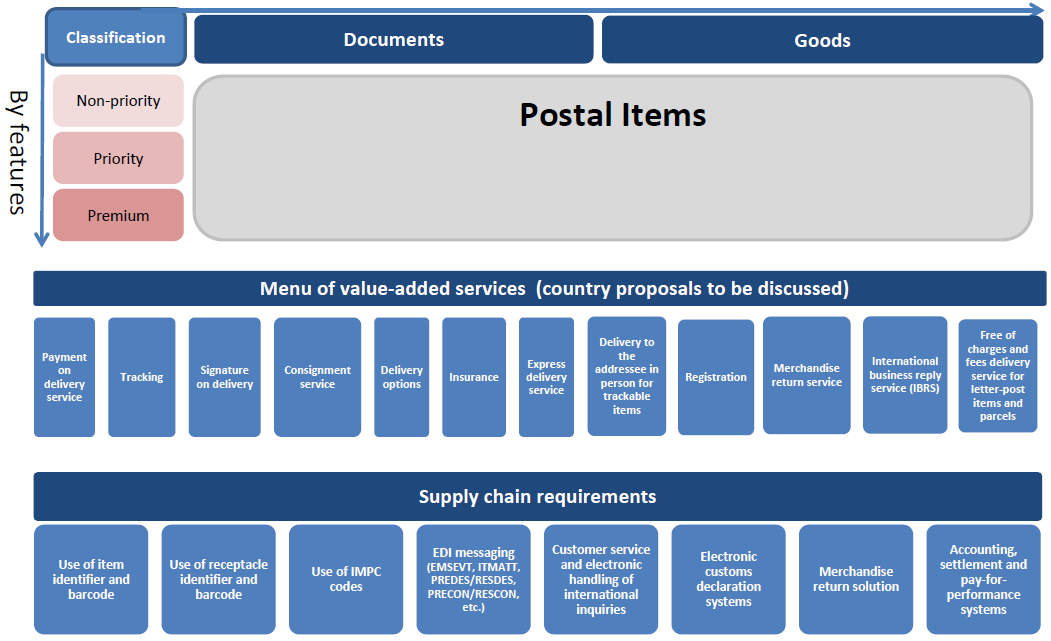- Home ›
- Digital Post Services ›
- Integrated Product Plan
The UPU Integrated Product Plan (IPP)
Goodbye to "letters" and "parcels", and hello to "postal items"

At A Glance
The UPU's Integrated Product Plan, adopted at the 26th UPU Congress in Istanbul in September 2016, said goodbye to "letters" and "parcels", and hello to "postal items".
The fundamental change in today's global mail mix,
triggered by the 2-digit growth in ecommerce, has lead to an unsustainable development.
Currently commercial items up to 2 kg in weight are predominantly sent
internationally as letter post items. These items have to be treated as commercial items (with
special treatment for customs and security purposes) and must be processed in
each operator's “parcel / package” stream. Not in the "letter post" stream which
is designed for transactional / document-based mail.
Consequently, the postal products and services currently
on offer don’t reflect the needs of the marketplace and its customers. And today's remuneration systems fail to cover operators’ delivery costs, particularly when these commercial letter post items are sent from south-east Asia.
In response, the UPU has developed an integrated
approach to product development and remuneration systems by modernising letter
post, parcel post and EMS, and ensuring speedier decision-making in response to
market needs.
Its Integrated Product Plan (IPP) (Fig. 1) is designed to eliminate product and weight silos, to differentiate postal items based on content (documents vs. goods), to provide a seamless 0 – 30 kg weight range, and to be compliant with security and customs requirements for electronic advanced data (EAD).
It will be submitted for adoption at the UPU Congress being held in Istanbul in September 2016.

Fig. 1: Three basic criteria for differentiation related to the product offering to overcome overlaps and distortions caused by old fashioned “product silos”: 1. Non-priority – quick, with limited value added services; 2. Priority – quicker, with choice of value-added services; 3. Premium – quickest, with most value-added services.
The IPP aims to ensure that the UPU has a fully integrated portfolio of physical products and adequate remuneration systems to cover the costs of delivering the products, and that the integrated portfolio of products meets the following requirements:
- Addresses the needs of the marketplace and well as the customers
- Creates differentiation based on content (documents and goods), remuneration, and product features
- Satisfies the need to provide a seamless 0 -30 kg weight range within the goods category (elimination of any weight silos)
- Eliminates product silos and creates simpler product offerings
- Facilitates efficient compliance with emerging security and customs requirements for electronic advanced data (EAD)
- Results in simplified regulations
- Ensures sustainability of the network and takes account of the different capabilities of member countries
Today's UPU product portfolio has a lot of overlap, especially amongst the lightweight items for letter-post, parcel-post and EMS.
This is mainly the result of letter, parcel and EMS services (within the context of the UPU) often having developed within silos, resulting in the dis-integration of features, product overlaps, and general customer / stakeholder confusion.
Creating the Integrated Product Plan
The first step in creating the IPP was to review the current product portfolio in order to highlight the product features, potential gaps, differentiations, overlaps and distortions between services:


Fig. 2: Portfolio overview of existing UPU physical products, 2015; Source: UPU POC C3 PSIP 2015.4-Doc 6.Rev 1 Annex1/1
This overview (Fig. 2) formed the basis for proposals to rationalize, modernize and integrate the different products in a more market and customer-focused manner, mindful also of the need to facilitate efficient compliance with emerging security and electronic customs pre-advice requirements (EAD).
The 8 principles of the IPP
- 2 fundamental principles:
- Principle of universality: Member countries are obliged to accept, handle and deliver both letter-post and parcel-post items in accordance with the conditions outlined in the UPU Convention.
- Principle of evolution: UPU must ensure that it can satisfy customers’ changing needs
- 6 integrational principles:
3. Principle of progression: The IPP application will be implemented, provided that the 26th UPU Congress will endorse the proposals, in a staged process
a. Step 1 - "Implementation of differentiation by content” (documents / goods split) will be implemented after the 26th UPU Congress and by 1 January 2018 (Fig. 3). This will entail creating documents/goods subcategories in the letter-post category, while letter formats "P" and "G" will be restricted to documents/correspondence only. Small packets - letter format "E" - will be moved to the goods category of letter- post. Parcels and EMS remain unchanged.

Fig.3: Step 1: Differentiation by content (documents / goods split)
b. Step 2 - "Achieving integration" - will be implemented, provided that the 26th UPU Congress will endorse the proposals, from 1 January 2018 until 1 January 2020. UPU members will adopt a fully integrated product portfolio in Step 2. All items will be classified as "Postal Items". Operational processing will be dictated by content (documents vs. goods), with levels of service and added features being established on a "menu" basis. (Fig. 4)

Fig.4: Step 2: Achieving integration
4. Compliance principle: The alignment of product development with emerging security and electronic customs pre-advice requirements has to be ensured
5. Differentiation principle: Strict definitions to differentiate the products will have to be applied:
a. Differentiation of products by content (documents vs. goods)
b. 3 basic criteria of differentiation related to the product offering
i. Non-priority: quick, with limited value-added services
ii. Priority: quicker, with choice of value-added services
iii. Premium: quickest, with most value-added services
6. Menu approach principle: applied to service level, price and value-added services
7. Simplicity principle: the aim is to simplify the range of product categories to minimize overlap and eliminate redundancies
8. Cost covering principle: adequate remuneration that is commensurate with the costs of providing the services or value add-ons has to be developed
"Postal items" to be redefined
As postal items are to be differentiated by content, a definition for both documents and goods will need to be introduced into the UPU Acts.
Proposed definition of “documents” in the UPU Acts:
“a postal item consisting of any piece of written, drawn, printed or digital information, excluding objects of merchandise, whose physical specifications lie within the limits specified in the Regulations”
Proposed definition of “goods” in the Acts:
“a postal
item consisting of any tangible and movable object other than money, including objects
of merchandise, which does not fall under the definition of “documents” as
provided above and whose physical specifications lie within the limits
specified in the Regulations.”
The
definition for the letter format “E” will be amended, as small packets
containing goods up to a weight of 2 KG will be classified letter-post items.
The definition of small letters (“P”) and large letters (“G”) will be amended
in the Letter Post Regulation, so that their content will be restricted to
documents only, up to a total weight of 500 grams.
The fact that future customs and security requirements will make the provision of electronic advance data (EAD) mandatory on all postal items containing goods will lead to an amendment of the Letter Post Regulation and make the application of the S10 identifier to small packets obligatory.
This will enable
the provision of cross-border EAD and is scheduled to become effective as of 1 January
2018.
The IPP will differentiate “postal items” as “documents” or “goods”, and create 3 new service categories “Non-priority – Priority – Premium”.
Consequently, remuneration will reflect the actual costs of providing delivery.
Will the Integrated Product Plan be welcomed?
The remuneration
received by a postal operator for providing last mile delivery in their national
territory depends upon the remuneration group to which the dispatching postal
operator belongs.
This gives certain countries a huge advantage.
For example, it is currently much cheaper
to send a commercial item from south-east Asia to Europe than it is to send the same item
across borders within Europe – a reflection of the existing system of terminal
dues.
Why?
A less
developed country pays less for last mile delivery in a developed country than
a developed country pays for the same service.
The laudable
principle adopted by the UPU of granting a less developed country a competitive
advantage in a developed postal territory for last mile delivery is a form of
development aid.
However, it
fails to reflect the realities of modern ecommerce: the nature of the global digital
economy is such that it is highly flexible and able to rapidly adapt, leveraging on the distortions
created by systems such as the UPU’s remuneration system.
Recognising the impact of such distortions, the UPU has responded with its Integrated Product Plan and similar proposals which are designed to return to a more level playing field.
The questions is, will its membership (192 member countries) agree on a consensual solution which
allows the UPU to uphold its role as a provider of a global postal network
designed to benefit all equally in the face of opposition from those who
currently benefit so dramatically from these distortions?
- Home ›
- Digital Post Services ›
- Integrated Product Plan
Does this article cover a topic relevant to your business? Access the CLS Business Lounge for the market intelligence you need to stay ahead of the crowd. Find out more



















